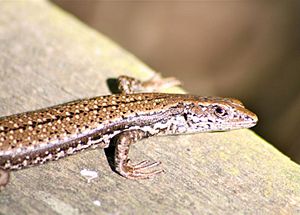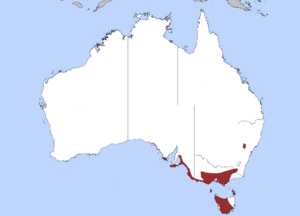Pseudemoia entrecasteauxii facts for kids
Quick facts for kids Pseudemoia entrecasteauxii |
|
|---|---|
 |
|
| Conservation status | |
| Scientific classification | |
| Genus: |
Pseudemoia
|
| Species: |
entrecasteauxii
|
 |
|
| Distribution of the southern grass skink | |
| Synonyms | |
|
|
The southern grass skink (Pseudemoia entrecasteauxii) is a type of lizard that belongs to the skink family. This small lizard is found only in Australia. You can spot it in the south-east part of the continent. It also lives in Tasmania and the islands of Bass Strait.
Southern grass skinks can live in different places. However, they are most often found in open, grassy woodland areas. These skinks usually live for about 5 or 6 years. They can grow up to 7.5 centimeters (about 3 inches) long, not counting their tail. Male skinks even change their colors during the time they look for a mate!
Etymology
The specific name of this skink, entrecasteauxii, honors a French naval officer and explorer. His name was Antoine Bruni d'Entrecasteaux.
Reproduction and Life Cycle
The southern grass skink is very interesting to scientists. They study it to learn more about how reptiles have babies. This skink is special because it gives birth to live young. Most reptiles lay eggs, but not this one!
Female skinks have a special connection inside their bodies. It's like a placenta in mammals. This connection helps give the baby skinks lots of food and nutrients. This happens while the babies grow inside their mother. The amount of food the mother eats is very important. If she doesn't eat enough, her babies might not develop well.
Sometimes, if food is very hard to find, a mother skink might even eat her own babies. This sounds harsh, but it's a way for her to survive when there's not enough food for everyone. This shows that having babies grow inside and feeding them through a placenta works best when there is plenty of food.
Scientists have also learned that fat (lipids) is important for the baby skinks. It moves from the mother to the babies through a part called the yolk sac placenta. A protein called lipoprotein lipase helps with this process.


